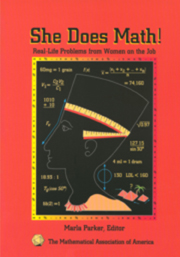Book contents
- Frontmatter
- Preface
- Contents
- Problems by Subject
- Environmental Psychology
- Software Engineering; Computer Science
- Archaeology
- Mathematics and Computer Science
- Civil Engineering
- Mathematics
- Electrical Engineering
- Physics; X-ray Astronomy Research
- Mathematics
- Physics; Astronaut Crew Training Instructor
- Business Data Processing
- Software Engineering; Real Estate Investment
- Quality Engineering
- Health Science
- Nursing Education
- Electrical Engineering; Space Systems
- Oil and Gas Accounting
- Business Administration Higher Education
- Aerospace Engineering
- Structural Engineering
- Computer Science
- Mathematics
- Dietetics—Foodservice Management and Nutrition
- Electrical Engineering
- Chemical Engineering, retired
- Software Engineering
- Immunology and Microbiology
- Mechanical Engineering
- HMO Pharmacy Practice and Management
- Ophthalmology
- Electrical Engineering
- Fish Pathology
- Computer Science and Computer Graphics
- Mathematics and Computing
- Electrical Engineering
- Astronomy
- Author
- Mathematics
- Reflections on WAM
- Solutions
Mathematics
- Frontmatter
- Preface
- Contents
- Problems by Subject
- Environmental Psychology
- Software Engineering; Computer Science
- Archaeology
- Mathematics and Computer Science
- Civil Engineering
- Mathematics
- Electrical Engineering
- Physics; X-ray Astronomy Research
- Mathematics
- Physics; Astronaut Crew Training Instructor
- Business Data Processing
- Software Engineering; Real Estate Investment
- Quality Engineering
- Health Science
- Nursing Education
- Electrical Engineering; Space Systems
- Oil and Gas Accounting
- Business Administration Higher Education
- Aerospace Engineering
- Structural Engineering
- Computer Science
- Mathematics
- Dietetics—Foodservice Management and Nutrition
- Electrical Engineering
- Chemical Engineering, retired
- Software Engineering
- Immunology and Microbiology
- Mechanical Engineering
- HMO Pharmacy Practice and Management
- Ophthalmology
- Electrical Engineering
- Fish Pathology
- Computer Science and Computer Graphics
- Mathematics and Computing
- Electrical Engineering
- Astronomy
- Author
- Mathematics
- Reflections on WAM
- Solutions
Summary
I was born in what was then called East Germany. My parents fled to West Germany while I was still in elementary school, and I received the standard schooling for college-bound students: beginning with a foreign language (English) in fifth grade, adding a second language (Latin) in seventh grade, and adding a third language (French) in tenth grade. After completing thirteen years of school, students could apply to a college. Schools offered no choices whatsoever, all subjects were mandatory. Once a foreign language was started, students had to continue with it through the thirteenth grade, although the class would not necessarily meet every day of the week. Mathematics was mandatory in all thirteen grades, and the study of single-variable calculus was completed in high school.
One experience during my high-school years definitely had an impact on my later life—I spent a year as an exchange student at an American high school. At the time, I thought the study of various subjects was much more intense in the American high school than in Germany. On the other hand, I didn't think students could retain much of what they learned, because they had such a short exposure to the subjects.
German students finish the 13th grade with the equivalent of American general education requirements in a liberal arts college. When the time comes to apply to a university, students also decide on a major. I was debating between foreign languages, mathematics, physics, and music.
- Type
- Chapter
- Information
- She Does Math!Real-Life Problems from Women on the Job, pp. 34 - 41Publisher: Mathematical Association of AmericaPrint publication year: 1995



